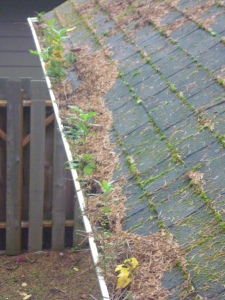Many posts have been written about how you should prepare your home for the winter months. Here in the willamette valley our

winters are not all that extreme. It does stay wet, however we don’t get much snow on the valley floor and our temperatures very rarely dip much below freezing. These moderate temperatures do have their own set of maintenance issues:
1. Gutters: Gutters, gutters, gutters. Did I mention gutters? Seriously, gutters. The manner in which we receive rain requires properly functioning gutters. For around 8 months we stay wet. Not huge downpours, just steady and wet. Every drop of rain that hits your roof is supposed to be concentrated and collected into a few spots around the home. If the collection system is plugged or allowing water to splash or dump around the home serious problems can develop. This is my number one thing to keep functional on my own home.
2. De-moss the roof. In general, every two years you will want to spread some moss killer. The shady slopes and roofs that are near large trees may need additional applications of the copper or zinc.
3. Remove the hoses from the outside water faucets.
I do not use the styrofoam cover thingys. Again, it is all about our climate. If you remove your hoses it will not usually get cold enough to need those cover thingys.

4. Crawlspace vents. There seems to be a viral belief in the necessity to plug the foundation vents. I do not think that this is a verygood thing to do. Most of our winter temperatures are going to be around 40 degrees. Pipes do not freeze at 40 degrees. More likely than frozen pipes is the possibility of moisture bubbling up from underneath the home. If the vents are all plugged, and water is present you have created a moist, stagnant area that is perfect for critters and fungus that eat the wood that is holding up your home. The moral of all of this is: Do not plug your vents unless it dips below 25 degrees, and as soon as it warms up again, take the plugs out.

